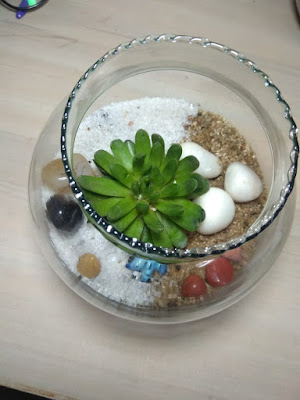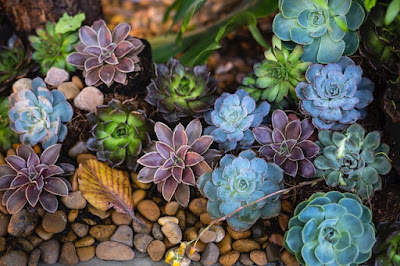Terrarium
What
is Terrarium
Simply put, a terrarium is a glass vessel that contains plants and soil,
creating a miniature ecosystem. These low-maintenance indoor gardens are an
attractive way to incorporate plants into a home, Garden or office setting
while providing a beautiful aesthetic and many other advantages.
 |
| Terrarium |
A
terrarium is a collection of small plants growing in a transparent, sealed
container. A terrarium is a closed environment and can actually be used to
illustrate how an ecosystem works. Inside a terrarium's walls, many different
natural processes may be observed: photosynthesis, respiration, and the water
cycle.
 |
| Terrarium |
Why
is Terrarium Gaining Popularity?
Terrariums
were incredibly popular in the 1970s and then slowly faded into the background.
In the last handful of years though, they are gaining popularity again for many
reasons.
It
is thought this current rise in popularity goes hand in hand with an overall
increased awareness of health and wellbeing. People are realizing the immense
benefits that nature, plants, and green spaces have on their physical and
mental wellness. To facilitate this connection when life and work keep you from
getting outside, indoor plants provide the same perks.
Choosing to garden in a terrarium provides you
with an incredibly low-maintenance way to garden indoors. Terrariums are fairly
self-contained and self-sufficient, needing little care. Depending on the type
you choose to have it may be weeks or months between basic tasks such as watering.
 |
| Terrarium |
How
Terrariums Work
The
micro-environment created within a terrarium is a miniature replication of our
natural world and the processes that occur in it. At the very basic level,
terrariums work because of the natural cycle water progresses through due to
evaporation, plant transpiration, and rainfall.
In a glass terrarium, moisture evaporates from both the soil (and
another growing substrate) and the leaves of plants due to the heat generated
from sunlight. It then collects and condenses on the roof and/or walls of the
display. The condensation falls back to the soil, mimicking the natural
rainfall cycle that provides moisture to all living creatures on our planet.
 |
| Open Terrarium |
Types
of Terrariums
(enclosed vs. Open)
When
most people think of terrariums, they envision the icon enclosed displays of
decades past. While still popular in their resurgence, these glass structures
have a lid that seals them completely creating a high humidity environment
within. The moisture inside a closed terrarium constantly recycles itself,
continuously providing water the plants need for growth. When properly designed
they can go months without needing any water.
Open terrariums are just what their name implies — displays that have an
opening to release moisture, creating a system that maintains a lower humidity.
This type works really for succulents or cacti. The moisture is still recycled
to a degree, but at a much lesser amount. Therefore, they require more frequent
watering than enclosed displays.
Building/Creating
Your Own Terrarium
In this day and age of do-it-yourself projects, many people are choosing
to build their own terrariums instead of purchasing one already constructed.
One benefit to building your own is having the ability to completely customize
it to your liking. It is also gives you the mental stress relief.
How to make a
terrarium
a) Start by selecting a clear glass container.
While colored glass looks pretty, it blocks some of the light from plants.
b) A wide mouth vessel is much easier to work
with, especially when you need to get your hands into it for planting.
c) Pair plants with similar humidity and
sunlight needs – Succulents are the best for to make a terrarium.
 |
| Succulents |
 |
| Succulents |
d) Choose slow growing plants or varieties that
stay shorter upon maturation.
e) Once you’ve collected all of your supplies,
it’s time to start putting everything together. Starting at the bottom of your
terrarium, there is a specific order to follow when building a display.
f) A thin layer of stones, small gravel, sand,
or bark chips to provide a collection area for drainage.
g) A thin layer of activated charcoal to filter
and purify the water.
h) A thin barrier over the charcoal layer to
prevent potting soil from settling. Commonly used items are screens, moss, or
simply paper in coordinating colors.
i) A layer of high-quality potting soil or
another growing substrate (such as coconut coir or sand, depending on the plant
requirements) to anchor the roots of your plants and retain moisture.
j) Now it’s time to arrange your chosen plants
in the terrarium, carefully planting them without disrupting all of the growing
substrate. After planting, some people like to add a top dressing such as small
gravel, bark chips, or moss to cover any visible soil. This layer helps to
retain soil moisture and adds visual interest as well.
And it’s ready to boom!
 |
| Terrarium |
How
long do closed terrarium last?
Can
a Terrarium Last Forever?
In theory, a perfectly balanced closed terrarium
– under the right conditions – should continue to thrive indefinitely. The
longest known terrarium lasted on its own for 53 years
Conclusion
Terrariums are a great way to maintain an
aesthetically pleasing, indoor garden. These miniature ecosystems are low
maintenance due to their glass enclosures and the naturally occurring recycling
of moisture that occurs within, yet provide many benefits to the audience of
their beautiful nature display.
Please do like, comments & share or simply mail us on yohiart@gmail.com
Want to learn about kokedama just follow the link below,
https://www.yohiart.com/2020/06/kokedama.html
Thank You!





















1 Comments
Thanks !
ReplyDelete